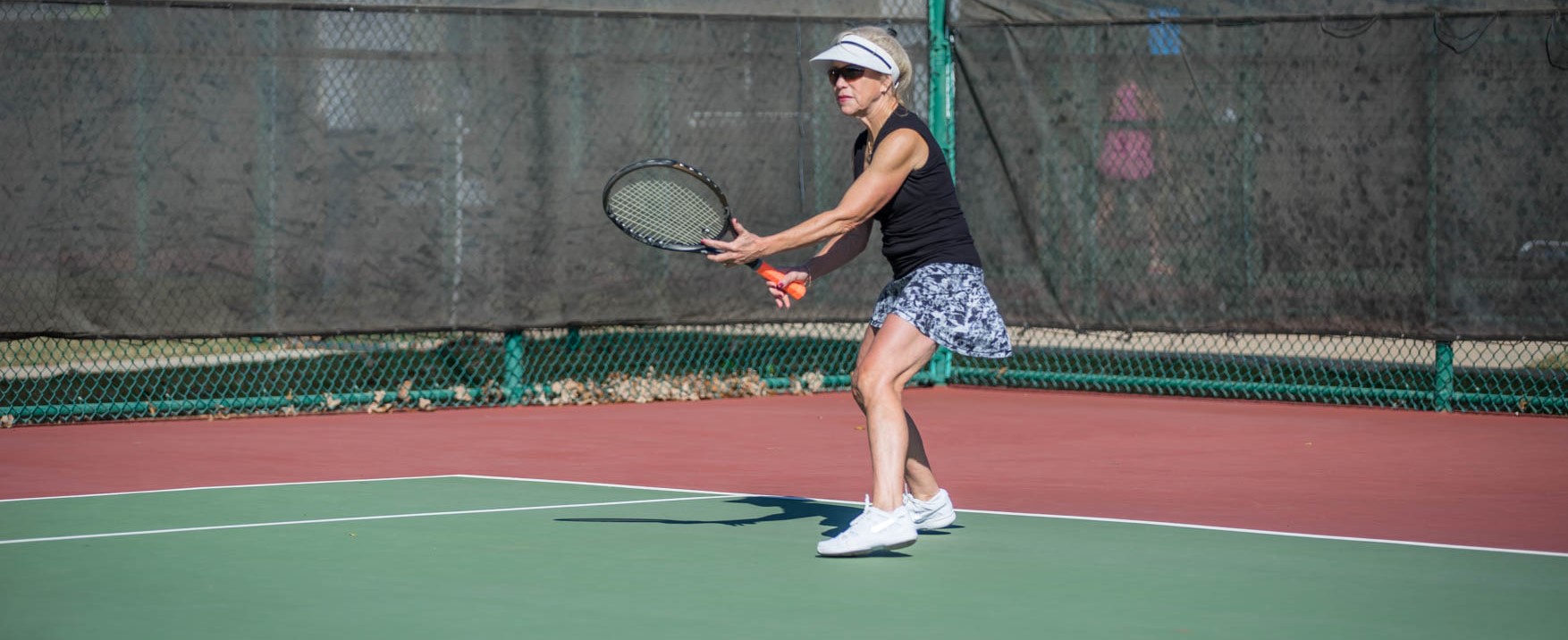
Whether playing singles or doubles, tennis is a great way to maintain health, fitness, strength and agility. It can be played as a sport or as a recreational activity with friends and family, and it helps to burn calories. It has been calculated that an hour-long game of singles tennis burns around 600 calories for men and 420 calories for women.
While it is not as high impact as sports like football, basketball or soccer, tennis brings its own set of injury risks. According to the U.S. Consumer Product Safety Commission more than 21,000 people are treated in hospitals, doctors' offices, clinics, ambulatory surgery centers, and hospital emergency rooms for tennis-related injuries each year.
An organization that collects data about tennis injuries is the International Tennis Federation (ITF). The ITF Sport Science & Medicine Commission (SSMC) is comprised of a group of sport scientists, physicians and tennis administrators from different parts of the world. Its members analyze and discuss the six areas of sport science relevant to tennis, including physiology, psychology, nutrition, biomechanics, motor learning and sports medicine in order to maximize healthy participation in tennis, reduce injury risk, and to facilitate optimal performance.
This commission offers three common tennis injuries and we talked with Dr. James Walter, an orthopedic surgeon, Dr. Richard Guyer, a spine surgeon and Dr. Chris Sakowski, a foot and ankle surgeon, all in the Dallas/Fort Worth area and members of the medical staff of Texas Health Center for Diagnostics and Surgery, who offered tips on their treatment.
Advice on Treating the 3 Most Common Tennis Injuries
#1 Tennis Elbow
According to the ITF, tennis elbow is the most common and also the most painful elbow injury in tennis players. An estimated 50 percent of all tennis players will suffer from tennis elbow in the course of their career. Players older than 35 are particularly at risk.
"Tennis elbow, which is also known in orthopedic medicine as lateral epicondylitis, is an overuse injury of the extensor muscles of the wrist," Dr. Walter said. "It is caused by inflammation of the tendons joining the forearm muscles to the outside of the elbow.

"This condition is similar to 'golfer’s elbow,' but it occurs on the outside lateral aspect of the elbow rather than the inside medial. Symptoms of tennis elbow include pain or burning on the outside of the elbow and weak grip strength. You may find that the symptoms are worse with forearm activity. The pain may also radiate into the arm, wrist and fingers.
Treating Tennis Elbow
"Tennis elbow can be can be controlled by training modification and relative rest," Dr. Walter said. "Physiotherapy such as friction massage, ultrasound and a standardized exercise program aimed at the mobility of the elbow and wrist along with stretching exercises and strengthening of the muscles of the forearm, upper arm and hand and manual therapy often have good effects.
"A corticosteroid injection may have a positive effect in the short term, but the long-term results are less positive than those of physiotherapy or rest. A more conservative approach is advised, especially with competitive tennis players. Some players may consider PRP or stem cell injections. Surgery is always the last option, but this can be considered if the pain persists for more than a year."
#2 Lower Back Pain
Low back pain is very common among tennis players according to the ITF. "Low back pain may have various causes, such as postural abnormalities, muscle dysfunction (imbalances, shortening or weakening of muscle), overuse, instability and articular dysfunction in the lower back. In tennis, the combined rotation, flexion and extension of the back during the serve may cause problems."
 "Because tennis serves require a combination of hyperextension, or bending the back, and side-bending and rotation of the trunk, pain and even stress fractures are a common injury," Dr. Guyer said. "This motion puts stress on the vertebrae in the lower back and can overtime cause additional stress on the portion of the vertebra which can cause muscle strains or in extreme cases conditions like spondylolisthesis, where the can vertebrae slip forward.”
"Because tennis serves require a combination of hyperextension, or bending the back, and side-bending and rotation of the trunk, pain and even stress fractures are a common injury," Dr. Guyer said. "This motion puts stress on the vertebrae in the lower back and can overtime cause additional stress on the portion of the vertebra which can cause muscle strains or in extreme cases conditions like spondylolisthesis, where the can vertebrae slip forward.”
Treating Lower Back Pain and Stress Fractures
"Rest, anti-inflammatory medications (e.g. Tylenol) and ice are recommended to relieve pain and muscle spasm," Dr. Guyer said. "However, I don't recommend bed rest beyond two days, as this can have detrimental effects on bone, connective tissue, muscle and the cardiovascular system.
"If the pain continues for more than two weeks, or if it is accompanied by other symptoms – such as shooting pain in the leg extending as far as the foot, a tingling sensation, numbness or loss of strength – a spine specialist should be consulted for further treatment."
#3 Sprained Ankle
The ITF notes that a sprained or twisted ankle is the most common tennis injury. In most cases, the injury is caused by landing on the outside of the foot, with the foot turning too far inwards. The relatively weak lateral ankle ligaments are then injured. An injury of the much stronger ligament on the inside of the ankle (medial ankle ligament) is far less common (5-10 percent of cases).

"Depending on the severity of the injury, the ligaments may be overstretched or torn, resulting in instability of the ankle," Dr. Sakowski said. "The symptoms are pain and swelling around the ankle, mainly on the outside, later followed by discoloration of the skin.
Treating a Sprained Ankle
"While this is a common tennis injury, it can lead to more serious complications if prompt action is not taken," he said. Here are the actions to take in the first 48 hours:
-
Don't play tennis or lean on the ankle.
-
Cool the painful area directly with ice, a cold pack or cold running water for 10 to 15 minutes. Repeat this several times a day (every 2 hours). Do not place the ice directly on the bare skin but cover the ice or cold pack with a towel first.
-
Apply a compressive bandage immediately. This will help with swelling of the ankle.
-
Elevate the lower leg and the ankle above the heart whenever possible (i.e., lie on the floor and place the entire leg on several pillows) to decrease swelling.
"Immediate and adequate first aid is important to help assist in a speedy recovery. In more serious cases, a visit to the doctor is recommended to rule out a fracture and to determine whether crutches or a boot is necessary."
4 Tips on Avoiding These Injuries
-
Get the right gear
Tennis professionals advise that players choose a tennis shoe with good support to help prevent ankle injuries. It is also important to ensure the racquet has the correct grip size and string tension to reduce stress on elbows and shoulders. A professional can help you to choose the right racquet.
-
Warm up thoroughly before playing and build core strength
It is critical for a player to have a good warmup before a game. This can help to lessen the chance of injury and improve one's game. Core and shoulder-strengthening exercises can also help to prevent injuries while serving.
-
Proper technique will help prevent injuries
Getting advice from a tennis pro is well worth the time and money it costs. This will help the player avoid extreme arches of the back while serving and balance his or her upper body weight by bending knees and raising heels instead. It is also important to be careful and try not to land on the balls of the feet while jumping, as this could result in an ankle injury.
-
Don't overdo it
Practice on the court is important, especially as it relates to the development of good technique. However, too much play can do more damage than good. The body needs time to recover between practices and matches, and overexertion can affect quality of play and worse, susceptibility to injuries. Don't overdo it and have fun!
If you have injuries from playing tennis that have persisted for more than two weeks, contact us to connect with an orthopedic specialist on the medical staff.
